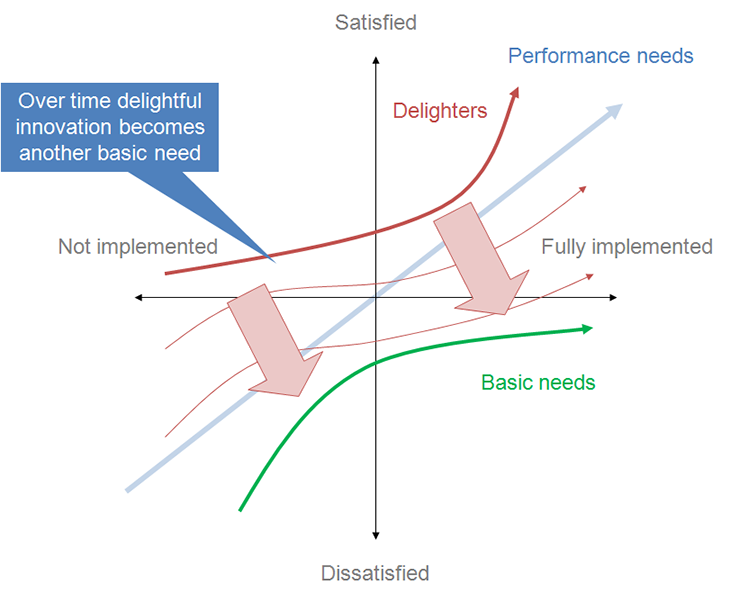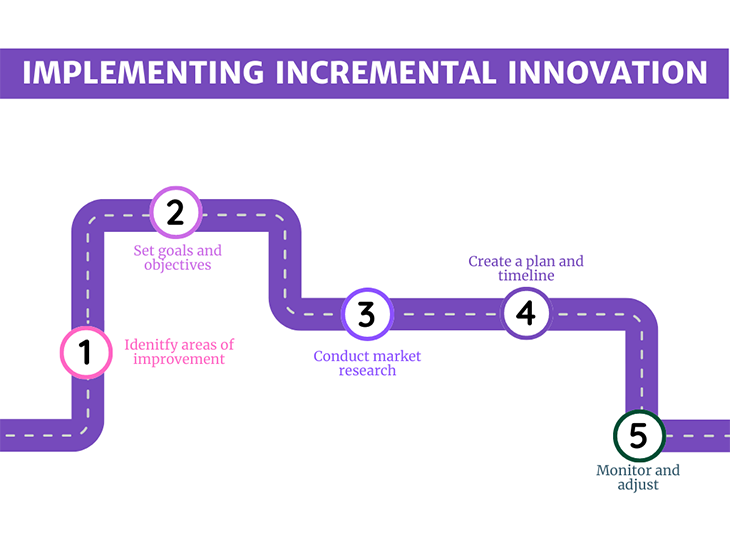Companies want to stay ahead of the game, and how can you achieve that if not through innovation?

Innovation is everywhere. Go into any company, and you will find either an innovation department, innovation embedded in the company vision or strategy, or both. But as product management author Dr. Kenneth B. Kahn observes, innovation is misunderstood by some organizations — they believe that innovation is only about breakthroughs and something new. They don’t consider minor, incremental innovation.
In this article, we’ll explore what incremental innovation is, its benefits and challenges, steps to implement it in product management, and go over a modern example of a company that was successful with it.
Incremental innovation involves minor changes to existing products, services, or processes. These changes can significantly improve quality, customer satisfaction, and cost-effectiveness. This type of innovation is often the result of ongoing research and development efforts and can involve improvements in product design, functionality, or efficiency.
Depending on the output, there can be various types of innovation:
In this article, we will focus on product innovation specifically.
Khan recognizes seven types of product innovation, ranging from incremental to radical innovation. The summary of each of them is as follows:
| Cost reduction | This involves changing the product’s price to differentiate the product from the competition. It does not have an impact on the actual product or its characteristics. |
| Product improvements | These are improvements in form or function and will replace the original product. Think about marketing messages such as “new and improved.” |
| Line extensions | Line extensions involve adding new features/options to an existing offering to provide further benefits the original product does not have. |
| New markets | This involves taking an existing offering to a new market (or geography) with little to no changes to the original product. |
| New users | This involves taking an existing offering and marketing it with a new use altogether with little to no changes to the original product. |
| New category entries | This refers to products new to a company’s offering but not new to the customer. |
| New to the world products | This refers to products that are new to a company’s offering and also new to the consumers. These are usually radical innovations. |
To illustrate the concept of incremental innovation, let’s consider the example of a smartphone. A smartphone is an existing product that undergoes incremental innovation every year. Each new model typically includes minor improvements such as a better camera, faster processor, or longer battery life. While these changes may seem insignificant, they can drastically impact customer satisfaction and sales.
One can also illustrate the concept of incremental innovation by thinking about the Kano model, depicted below. When the smartphone first appeared, it was a radical innovation and focused on delighters. It was new, and you essentially had a small computer in your hands:

Over time, the fact that it was small enough to fit into your hand was a given, and therefore it was considered a basic need. Companies needed to devise other ways to delight customers through the minor changes mentioned above — better cameras, faster processors, or other gimmicks.
Now that we’ve defined incremental innovation, let’s explore some of its benefits to product management.
Incremental innovation can lead to significant improvements in product quality over time. By continuously making minor improvements, companies can address issues and refine their products until they are of the highest quality. This can lead to increased customer satisfaction and loyalty, which can help drive sales and revenue.
For example, Apple’s incremental innovation efforts with their AirPods led to an improved design and sound quality in subsequent models. This helped them retain their position as a market leader in wireless headphones.
Companies can better meet their customer’s changing needs and preferences by making incremental improvements to existing products. This can lead to increased customer satisfaction and loyalty.
For example, car manufacturers continuously make minor vehicle improvements, such as adding new safety features or improving fuel efficiency. This can lead to increased customer satisfaction and repeat business.
Incremental innovation can also be a cost-effective way to improve products. Rather than investing significant resources in creating entirely new products, companies can make minor improvements to existing ones, leading to cost savings.
For example, a software company might make small changes to its existing software to improve performance and functionality rather than invest in an entirely new software product.
Incremental innovation can also provide a competitive advantage. By continuously improving existing products, companies can differentiate themselves from their competitors and attract customers looking for the best products.
For example, Samsung’s incremental innovation efforts with its Galaxy smartphones have helped them maintain its position as a leader in the smartphone market.
Essentially, incremental innovation is an integral part of product management. Even if you are not calling it that, it relies on the essence of being agile — iterating and shipping a better version of the product in every increment.

To implement incremental innovation in product management, companies should follow a few key steps:
While one may think that incremental innovation is actually product management, here are some common challenges:
Resistance to change is one of the biggest and widest-spread challenges across companies, even beyond innovation. We all know the famous saying “But we have always done it like that.” People are creatures of habit and most of the time, the first reaction to change is to fight it.
That’s why you want to have clear communication and change management plans to adopt new processes or ways of working — especially when you want to adopt a new mindset.
Make sure to explain the benefits from their perspective and involve the relevant stakeholders in the process. This way, you build a sense of ownership.
Another thing you can do is find ambassadors and use them to multiply your message. There are always a few stakeholders who strongly believe in the change and will support it.
As mentioned above, incremental innovation means evolving the product and focusing on quick wins to improve user satisfaction or retention.
But what do these quick wins and improvements need to address? More often than not, the product team will come up with ideas for improving certain features, but focus on their own needs and wants. They fail to consider the users and their particularities.
So be extra careful when you prioritize improvements and quick wins, and always look at them with a critical eye. Try to link them to the customer’s needs and wants. Impact mapping is a useful tool to help you not lose track of that.
Nokia’s refusal to believe that smartphones will be the next big thing in the telecom industry is infamous for its decline. But what does that have to do with incremental innovation?
You don’t operate in a void or a monopolistic market, so it is not enough to only focus on your customers and the discovery activities we perform. You also want to constantly monitor your market (and adjacent markets) to look for future trends to include in your incremental innovation strategy.
The most recent example is the rise of ChatGPT. Every day we see the announcement of new apps and tools based on ChatGPT, but also established products (hello Microsoft Office) announcing some sort of integration with this new form of AI. Now is the time to ask yourself, “What needs or problems could we be solving for our customers if we were to also include ChatGPT-like features in our product? Will they contribute to our objectives or not?”
To be innovative, a company needs to embrace the idea of continuous improvement and the fact that it is OK to fail, especially if you fail fast.
Managers and teams should be encouraged to take calculated risks and experiment to drive their products forward and stop playing it safe.
A mindset of “Let’s not do this to not upset the customer, but the customer asked for X, why don’t we just do it?” will definitely hold you back. You need your teams to be confident in saying no to these requests and have the data to back their answers.
“No, it does not make sense to build feature X the customer requested, as our data shows they actually need Y. Let’s do a quick prototype and test to see what their feedback is” will get you further than spending a few sprints building what the customer requested to only get feedback that it’s not what they need.
Let’s consider the WhatsApp messaging app and look at some incremental innovations they delivered to remain competitive and improve customer satisfaction.
| Voice and video calling | WhatsApp initially launched as a messaging app, but over time, they added the ability to make voice and video calls. This significant incremental innovation allowed users to communicate in new ways without switching to a different app. |
| End-to-end encryption | WhatsApp implemented end-to-end encryption for all messages in 2016 — a significant security upgrade. This incremental innovation improved the privacy and security of messages sent on the app. |
| Voice messages | In 2013, WhatsApp introduced the possibility of sending voice messages through the app. |
| Status feature | WhatsApp introduced a status feature in 2017 that allows users to post pictures or videos that disappear after 24 hours. This incremental innovation put WhatsApp in line with other social media apps and allowed users to share more than just text messages. |
| Group calling | In 2018, WhatsApp added the ability to make group voice and video calls, another significant incremental innovation. This allowed users to communicate with multiple people simultaneously, making the app more versatile and valuable. |
| QR codes | WhatsApp added QR codes in 2020, allowing users to quickly add new contacts without manually entering their phone numbers. This incremental innovation improved the user experience by making connecting with others on the app easier. |
| Communities | WhatsApp further improved support for business accounts by rolling out the Communities feature in 2022. This aimed to support admins in sharing information with their groups, thus bringing multiple chats under the same roof. |
These incremental innovations have helped to make WhatsApp a more versatile and valuable messaging app, attracting more users and increasing engagement. By continuously improving its product, WhatsApp has stayed ahead of the competition and maintained its position as a market leader.
In summary, incremental innovation is essential for businesses looking to improve their products and services without starting from scratch. Embracing incremental innovation is not only a way to remain competitive but also a way to continuously improve and exceed customer expectations.
If we were to boil it down, we can say that product management is incremental innovation. It is all about doing what we do best — balancing user and business needs, always looking out on the market, talking to the users, deciding which tradeoffs to make, and what to prioritize in the best interest of the product. The ultimate goal is to solve user problems and remain profitable in the long run.
Featured image source: IconScout

LogRocket identifies friction points in the user experience so you can make informed decisions about product and design changes that must happen to hit your goals.
With LogRocket, you can understand the scope of the issues affecting your product and prioritize the changes that need to be made. LogRocket simplifies workflows by allowing Engineering, Product, UX, and Design teams to work from the same data as you, eliminating any confusion about what needs to be done.
Get your teams on the same page — try LogRocket today.

A practical five minute revenue estimation method to help product managers compare ideas, drop low impact features, and prioritize smarter.

A practical guide for PMs who want to stop being bottlenecks, delegate smarter, and lead teams effectively with a clear ownership framework.

Stop letting unreliable data block features. Treat data as inventory to track quality, ownership, and ship with confidence.

Learn why slide decks slow teams down and explore better tools like whiteboards, PRDs, and prototypes to improve collaboration and alignment.